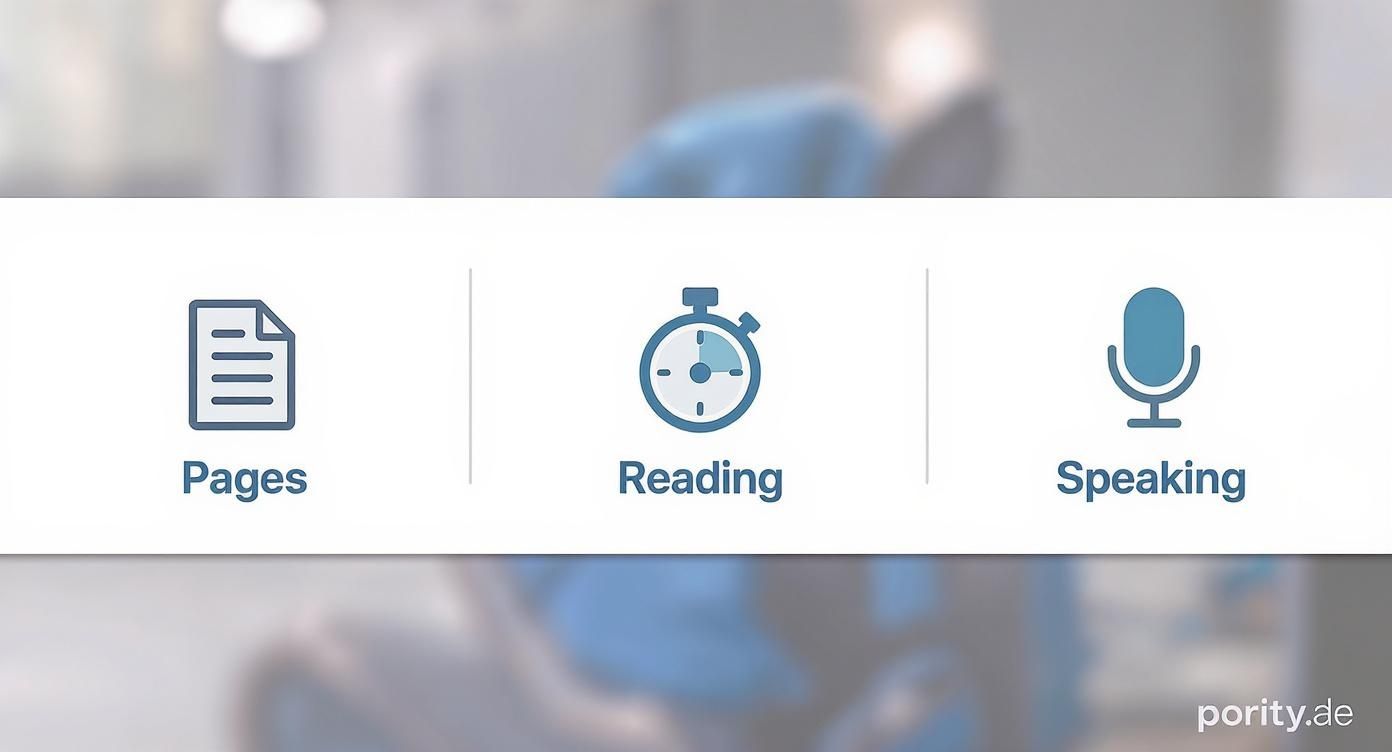How Long Is 500 Words? A Visual Guide
Ever wonder how long is 500 words? Our guide visually breaks down 500 words into pages, reading time, and speaking time with practical, real-world examples.
Posted by
Related reading
8 Actionable Peer Review Feedback Examples (2025 Guide)
Master the art of critique with our comprehensive peer review feedback examples. Learn to give constructive, actionable feedback that helps everyone improve.
How to improve academic writing: A practical guide
how to improve academic writing: practical tips, clear examples, and proven methods to boost clarity, coherence, and scholarly impact.
How to humanize ai text: Turn AI into natural writing
Discover how to humanize ai text with practical techniques to make AI writing feel authentic, engaging, and easier for readers to connect.
Ever wonder what 500 words actually looks like? It's the sweet spot for so many things—think of a detailed email to a colleague, a short but punchy blog post, or a single-spaced page in a Google Doc. A 500-word count is just enough to dive into an idea with some real substance, but it's still short enough for someone to read in a couple of minutes.
Your Quick Guide to 500 Words
Think of 500 words as the perfect length for getting a clear, focused message across without making your reader's eyes glaze over. It strikes an ideal balance between depth and readability, which is why it's a go-to for everything from website pages to school assignments. You have enough room to introduce a topic, back it up with a few key details, and wrap it up cleanly.
To make it even clearer, here’s a quick breakdown of what 500 words translates to in pages, reading time, and speaking time.

As you can see, 500 words is a surprisingly manageable chunk of text, whether you're the one writing it or the one reading it.
To give you a handy cheat sheet, here's a summary of the most important metrics.
500 Words At a Glance
This table breaks down the essential numbers for 500 words into a simple, at-a-glance format.
| Metric | Average Estimate |
|---|---|
| Pages (Single-Spaced) | 1 page |
| Pages (Double-Spaced) | 2 pages |
| Paragraphs | 5–10 paragraphs |
| Sentences | 25–35 sentences |
| Reading Time (Average) | ~2 minutes |
| Speaking Time (Average) | ~3 minutes |
These are great benchmarks to keep in mind for planning your content.
Reading and Speaking Time
How long it takes to get through 500 words really depends on who is doing the reading and why. For a typical adult, the average silent reading speed is about 238 words per minute. A little quick math shows that 500 words will take just over two minutes to read.
When you're reading aloud, however, things slow down. The average speaking rate is closer to 183 words per minute, which stretches the time to nearly three minutes. If you're curious about the science behind these numbers, you can explore some fascinating reading speed statistics. This makes 500 words a solid benchmark for everything from a short presentation to a timed essay.
What 500 Words Looks Like on the Page
Talking about 500 words in the abstract is one thing, but what does that actually look like when you sit down to read it? The truth is, the physical length of your text can change dramatically with a few simple formatting tweaks. Getting a handle on this is crucial, whether you're trying to hit a page count for a college paper or making sure a blog post isn't a wall of text.
The biggest player in this game is line spacing. Single-spaced text is compact, squeezing more words onto a page, which is why you see it all the time in web content and business reports. Double-spacing, on the other hand, intentionally adds a cushion of white space between each line, basically doubling the page count. It’s the standard for academic essays for a reason—it gives professors room to bleed red ink all over your work.
Single Spacing vs. Double Spacing
Think of it like this: single-spacing is the city apartment of text—everything is packed in tight and efficient. Double-spacing is more like a suburban house with a yard; every line has room to breathe.
Here’s a side-by-side look at the exact same text, formatted with both single and double spacing in a standard document.
As you can see, 500 words fits neatly onto one page when single-spaced. But hit that double-space button, and it immediately spills over onto two pages.
The Impact of Font Choice
Spacing isn't the only thing that matters. The font you pick also plays a surprisingly big role in how much real estate your words take up. Not all fonts are built the same.
A classic serif font like 12-point Times New Roman, the old standby for academia, is a bit more compact than a clean sans-serif font like 11-point Arial, a popular default for its readability on screens.
This subtle difference means that even with the same word count and spacing, your document’s final length can shift. Let's break down the two most common choices:
- Times New Roman (12 pt): This is the gold standard. Using this font, 500 words will almost always fill exactly one page when single-spaced.
- Arial (11 pt): Because its characters are a little wider, using Arial might push your text onto a second page by just a few lines. It’s a small but sometimes critical difference.
How Long Does It Take to Read or Speak 500 Words?

Beyond page counts and formatting, the most practical question is usually about time. How long will it actually take someone to read or listen to 500 words?
There’s no single magic number. The answer is a spectrum that depends entirely on the person and the situation.
Think of it this way: a university student speed-reading a research paper for keywords is in a totally different headspace than someone meticulously studying a technical manual. The same goes for speaking. A fast-talking auctioneer’s pace is worlds apart from a presenter delivering a thoughtful, deliberate speech.
These variables mean any "average" time is just a starting point. Your audience's goal, the complexity of your text, and the delivery style all play a massive role.
Estimating Time Based on Speed
To get a more realistic estimate, we can look at different words-per-minute (WPM) rates. A slower pace is perfect for absorbing complex ideas, while a faster one is built for quick overviews.
This flexibility is exactly why 500 words is such a sweet spot for online content. Deep research from Chartbeat analyzing millions of articles found that pieces this length hit a high-engagement sweet spot. The average engaged time for a 500-word article is 2 to 3 minutes—fitting perfectly into the modern attention span.
So, how does this break down in practice? The table below gives a handy comparison for both reading and speaking at different speeds.
Reading and Speaking Time for 500 Words
This table breaks down how quickly—or slowly—500 words can be delivered, depending on the context.
| Speed (Words Per Minute) | Reading Time | Speaking Time |
|---|---|---|
| 130 WPM (Slow Presenter) | N/A | ~3 minutes, 50 seconds |
| 160 WPM (Average Presenter) | N/A | ~3 minutes, 8 seconds |
| 240 WPM (Average Adult Reader) | ~2 minutes, 5 seconds | N/A |
| 300+ WPM (Fast Skimmer) | ~1 minute, 40 seconds | N/A |
As you can see, the time required changes dramatically based on whether you're speaking or just reading silently.
Pro-Tip: Always time yourself reading a script out loud at a natural pace. Most people speak much slower than they read silently. Relying on your reading time alone can completely throw off your presentation schedule.
Structuring 500 Words for Maximum Impact

Knowing how long is 500 words is one thing, but making those words count is a completely different game. The way you arrange your sentences and paragraphs is the blueprint for your reader's experience—it guides them, keeps them engaged, and makes your point land with force.
There's no single magic formula, but there are definitely smart strategies. Sentence length, for instance, controls the rhythm of your writing. Short, punchy sentences create a sense of speed and clarity. They’re perfect for grabbing attention in an intro or hammering home a key takeaway.
Longer, more complex sentences ask the reader to slow down, giving them space to absorb a detailed idea or picture a scene. The real trick is to mix them up. That variety is what keeps the writing from feeling flat and predictable.
Paragraphs That Work for Your Context
The purpose of your writing should dictate your paragraph structure. For online content like a blog post, scannability is everything. People rarely read word-for-word; they skim. This means shorter paragraphs, often just 2-3 sentences long, are your best friend. They create white space, making the text feel less like a wall of words and more inviting.
A 500-word article is typically composed of 5 to 10 paragraphs. For anything on the web, aiming for the higher end of that range—closer to 10 paragraphs—is a smart move. It breaks your ideas into bite-sized, digestible pieces.
This is a world away from traditional academic writing, where paragraphs are often dense blocks designed to unpack a single, complex argument. If you're working in that space, learning how to improve academic writing offers a whole different perspective on building a text.
But for most digital needs, this simple, modular structure is a reliable go-to:
- Introduction: One punchy paragraph (around 75 words) to hook the reader and state your point.
- Body: Three or four focused paragraphs (around 100 words each) to build out your main ideas with evidence or examples.
- Conclusion: One final paragraph (around 75 words) to summarize everything and tell the reader what to do next.
Thinking about it this way makes that 500-word target feel much less intimidating and a lot more strategic.
Real-World Examples of 500-Word Content
https://www.youtube.com/embed/UrMH1xlirpo
It's one thing to talk about numbers and page counts, but seeing where a 500-word piece shows up in the real world makes the concept click. This word count is a true workhorse. It hits a sweet spot that feels both substantial and quick—long enough to explore an idea properly but short enough to respect a reader's time.
You probably read 500-word articles every single day without even thinking about it. It’s the perfect length for a sharp, informative piece that gets straight to the point. While it might sound like a lot at first, it’s actually a very manageable and effective length for both writers and readers.
Common Uses for a 500-Word Count
So, where does this magic number truly shine? You'll find it's the foundation for many common types of writing where clarity and brevity are everything. The goal isn't to be exhaustive; it's to deliver value quickly, without any fluff.
Here are a few prime examples:
- Short Blog Posts: For a topic that doesn’t need a deep, multi-faceted exploration, 500 words is ideal. It’s just enough space to introduce a problem, offer a solution, and wrap up with a clear call to action. Many of the most successful blogs use this length for quick tips, news updates, or single-idea explainers.
- News Articles: Most online news summaries or local stories land right in this ballpark. It lets a journalist cover the essential details—the who, what, where, when, and why—without bogging down readers who just want a fast update on what happened.
- Product Descriptions or Landing Pages: A business has enough room in 500 words to highlight key features, explain the real-world benefits, and answer a few common questions. It’s a great way to be persuasive without creating a wall of text that scares potential buyers away.
- College Application Essays: Many supplementary college essays or scholarship prompts come with a strict 500-word limit. This forces applicants to be incredibly focused and impactful, telling a compelling story within a tight frame.
The strategic power of 500 words lies in its ability to force focus. It demands that every sentence serves a purpose, cutting out the fluff and leaving only what’s most important for the reader.
Why This Length Is So Effective
The reason 500 words works so well across these different formats comes down to one thing: reader engagement. It aligns perfectly with the average person's attention span online, taking only about two minutes to read. This makes it an incredibly powerful tool for communicating a core message before your reader has a chance to get distracted and click away.
For writers, especially those using AI to get a first draft down, a 500-word piece is a fantastic starting point. It provides a solid foundation that can then be polished and refined into something great. If you're looking to make that AI-generated text sound more natural and connect with your audience, you can find great tips on how to humanize AI text.
Ultimately, whether you're drafting an email newsletter, a press release, or a key scene in a story, the 500-word structure provides a reliable and effective framework for clear communication.
Frequently Asked Questions About Word Count

Even after you get the basics down, the real questions pop up when you're staring at a blank page with a deadline looming. Suddenly, knowing what 500 words looks like feels very different when you're dealing with specific formatting rules or a tight schedule.
Let's tackle some of the most common questions head-on. This should clear up any lingering confusion and help you apply this knowledge to your own work with confidence.
How Many Pages Is 500 Words in a Book?
In a standard 6x9 inch paperback, 500 words usually takes up about 1 to 1.5 pages. But this is just a ballpark figure—the actual space depends heavily on the book's specific trim size, font choice, and overall page design.
What's almost certain is that it's less than a full chapter. Book designers play with spacing, margins, and line height to make reading comfortable, so the word count per page can vary a lot more than in a simple Word document.
How Long Does It Take to Write 500 Words?
This is the classic "it depends" question. The time it takes to write 500 words can be anywhere from 15 minutes to over two hours. A seasoned writer who knows the topic inside and out might hammer out a draft in no time, but that's rarely the full story.
For most people, a realistic timeframe is 1-2 hours. This accounts for the entire process: researching, outlining your thoughts, actually writing, and then editing for clarity and typos. If you're a student working on a thoughtful essay, budgeting at least an hour is a smart move.
Do Headings Count Towards a Word Limit?
Almost never. When a professor, editor, or client gives you a word limit, they are almost always referring to the main body text. In other words, the paragraphs are what matter.
Here’s what’s usually left out of the final count:
- The main title and any subheadings
- Captions for images and charts
- Any text inside a table
- Bibliographies, works cited, or reference lists
You should always double-check the specific guidelines for your project, but excluding these extra bits is standard practice. And when it comes to academic work, giving solid feedback is just as important as writing; you can sharpen your editing skills by looking at some great peer review feedback examples.